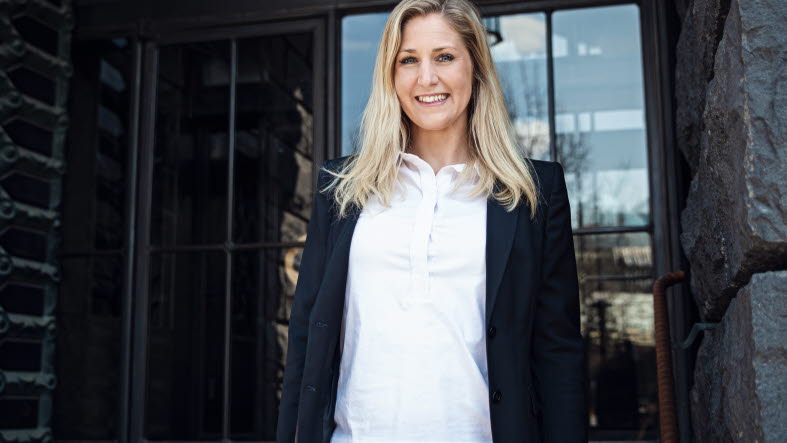Lina Fransson sits on the trading floor in between sales and trading in an advisory role to a range of institutional clients, with a finger right on the pulse of the rates and FX markets. She has been with SEB for just over eight years prior to which she worked in the Monetary Policy Department at Sweden’s Riksbank. Her main focus is on how the Riksbank and other central banks influence the fixed income and FX markets. Analyses focus primarily on institutional customers but also on companies with treasury departments.
“We guide customers on how they should manage their fixed income and currency exposures. It is always hard as an analyst to say something definite, but by looking at things in detail and digging deep within our area of expertise, we can provide added value to customers which in the end hopefully can lead to them doing business with us,” she says.
Major transition
A major transition has taken place in the fixed income and FX market since 2022.
“We have gone from a period, which lasted more or less my entire working life, where inflation has been low and interest rates have fallen and the problems related to how to get inflation to rise. The major change came last year with the inflation shock that followed in the wake of the tragic war in Ukraine.”
The inflation chock has led to a painful transition for many households and companies, but also to a more interesting and eventful market for an analyst, she believes.
“On the one hand, we have chased risk because interest rates have been so low and on the other there has been less anxiety about hedging positions. It is a very different environment we have experienced in the past eighteen months compared with the previous decade,” she says.
What do customers ask about most right now?
“It is very much about whether or not the central banks have finished raising rates. When might the first interest rate reduction take place? Why is the Swedish krona so weak? There has been some uncertainty primarily from international investors relating to commercial properties.”
The weak krona has also led to a renewed Euro debate in Sweden.
“This will be an ongoing discussion as long as the krona is weak. Should the krona strengthen, I believe this debate will disappear again. It is a political discussion and nothing that we at the bank or companies and institutions take concrete account of in their analyses.”
How does this look going forward? What will happen to the krona exchange rate?
“Our forecast is that the krona may remain weak during the autumn, very much linked to a weak economic development. In such an environment, the dollar trends to be strong and in general the krona has a rather tougher time.”
Structural changes
Looking ahead, however, Lina Fransson emphasises that there may be a change in a number of structural factors which have been weighted negatively against the krona for many years.
“The stock market has done well, and Swedes tend to save abroad. We have taken our money out to global funds and at the same time there have not been major opportunities to invest in Sweden, since the supply of government bonds has been low.”
In its earlier efforts to push down interest rates and thereby get inflation to rise, the Riksbank purchased government bonds and owns about half of Sweden’s outstanding government bonds. Now the Riksbank wants to tighten the economy and has therefore started selling off bonds. This increases supply which leads to a rise in long-term interest rates.
“Looking ahead, we have a Riksbank that sells government bonds which can attract foreign investors. The less favourable situation on the stock market combined with high interest rates, means that we believe households will reduce their stock market investments and instead choose to pay off their loans. The structural outflow will then disappear.
“If we take a look into 2024, there is therefore reason to believe that the krona can enjoy a little revenge, particularly in combination with the fact that Sweden has very strong government finances that can be used to stimulate the economy. This should be able to provide a positive growth effect for Sweden, which may enter recession faster but can also emerge from it faster than other countries.”
Hedging of currency reserves
An additional factor is that the Riksbank has started to actively hedge its currency reserves. The Riksbank holds approximately 400 billion kronor in liquid assets in foreign currency. In the event of a crisis which makes it difficult for Swedish banks to renew their borrowing in foreign currency, the Riksbank can then go in and support the financial system with foreign currency.
What has happened in the past year when the krona has weakened is that the Riksbank has earned money from the currency reserve. This corresponds to unrealised gains in excess of 100 billion kronor.
In June, the Riksbank said that it would start to currency hedge parts of these unrealised gains. This is done on the derivatives market which means that you lock in the krona exchange rate three to four months ahead. Should the krona strengthen during this period, the unrealised gain has been secured.
“The Riksbank has announced that it will hedge one-quarter of the currency reserve on the derivatives market. In this way, the Riksbank will be a player which buys kronor. It is uncertain whether this is a sufficiently large flow to have an effect, but it has value as a signal that, on the margin, can contribute to strengthening the krona.
All in all, these factors indicate that the krona can gain upward support, says Lina Fransson.

